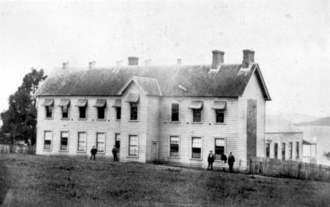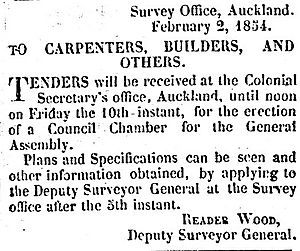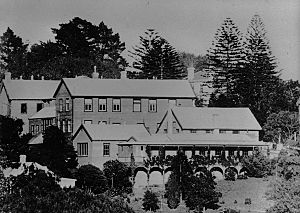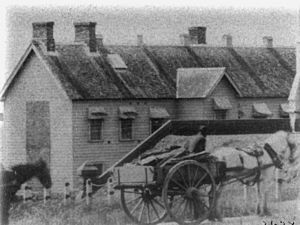General Assembly House facts for kids
Quick facts for kids General Assembly House |
|
|---|---|

The General Assembly House in Auckland in 1861, known as the "Shedifice"
|
|
| General information | |
| Architectural style | none |
| Town or city | Auckland |
| Country | New Zealand |
| Coordinates | 36°50′57″S 174°46′24″E / 36.849204°S 174.773425°E |
| Construction started | March 1854 |
| Completed | May 1854 |
| Opened | 24 May 1854 |
| Demolished | December 1917 |
| Design and construction | |
| Architect | Reader Wood |
The General Assembly House was the very first building where the New Zealand Parliament met in Auckland. Members of Parliament (MPs) sometimes called it the "Shedifice" because it looked like a large shed. This building was used by Parliament from 1854 to 1864. During this time, Auckland was the capital of New Zealand.
The building was also used by the Auckland Provincial Council, which was like a local government for the Auckland area. After these provincial governments were ended, the building was used by the government's survey department. Later, it became part of Auckland University College. The General Assembly House was pulled down in 1917 to make way for a road called Anzac Avenue. Today, a small park near Parliament Street remembers where New Zealand's Parliament first met.
Contents
History of the General Assembly House
Why a New Building Was Needed
Auckland was New Zealand's capital city from 1841 until 1865. In 1865, the capital moved permanently to Wellington. At first, New Zealand's government was run by a small group of public servants chosen by the governor.
Things changed when a new law, the New Zealand Constitution Act 1852, was passed. This law gave New Zealand more control over its own government. It created a "General Assembly" (or Parliament) with two main parts: the New Zealand Legislative Council (whose members were chosen) and the New Zealand House of Representatives (whose members were elected by the people). The first general election happened in 1853.
Parliament Meets for the First Time
On 18 January 1854, it was announced that Parliament would meet in Auckland on 24 May that year. This date was chosen because it was Queen Victoria's birthday. However, there was no suitable building in Auckland for the General Assembly to meet in.
Reader Wood, who was a deputy surveyor-general, was given the job of designing a building. This building would be used by Parliament when it was in session and by the survey department when Parliament was not meeting. Construction began quickly in March 1854 and cost £2,572. Even with a shortage of workers and bad weather, the building was mostly finished by 23 May.
The first meeting of MPs happened on 24 May. Later that evening, a special ball was held in the House of Representatives chamber. About 200 guests attended, even though the weather was poor. The chamber was a large hall, so it could easily be used for a ball.
Before Parliament could officially open, the House of Representatives needed to choose a Speaker. Charles Clifford was chosen by everyone. Then, on 27 May 1854, Colonel Robert Wynyard, who was acting as governor, officially opened Parliament.
The General Assembly House was also used for meetings of the Auckland Provincial Council. This usually worked well because many MPs were also members of the provincial councils. Their meetings were planned so they wouldn't happen at the same time. Only a few times did their schedules clash. When this happened, the provincial council would sometimes move their meetings to another building, like the Mechanics' Institute, or even to the library room attached to the General Assembly House.
Changes in Ownership and What Happened to It
In late 1858, the building's ownership was given to Auckland Province. However, Parliament still had an agreement to use it. The building was also expanded a bit after 1858.
In 1876, the provincial government system was ended. The building then went back to being owned by the Crown (the government). In 1883, some parts of the building that used to house Auckland's local court were given to the new Auckland University College. These areas became laboratories and lecture rooms for chemistry students.
The original part of the building was still used by the Survey and Crown Lands Department. In 1890, the main building and its land were also given to the college. The college used the former House of Representatives meeting room for general and mathematics lectures. The lower floor of the original building became the college library and office.
On 15 November 1917, the Mayor of Auckland City, James Gunson, held a special event to remember the building's history. This happened just before it was pulled down. The buildings were demolished to make way for a new main road called Anzac Avenue. A year later, Eden Street was renamed Parliament Street. A plaque in a nearby park marks the spot where the General Assembly House once stood.
Architecture of the "Shedifice"
Many people did not like the look or quality of New Zealand's first Parliament building. The Daily Southern Cross newspaper called it a "wretched, ill-constructed building." It was known to be drafty, and its roof often leaked.
Henry Sewell, who became New Zealand's first premier (like a prime minister) in 1856, described the building this way:
The Room of moderate size—plain and with no architectural pretension whatever. The whole building is of the most undecorated style—a great wooden barnshaped affair, which might serve for a Hospital, a Jail, or a Barrack—or if gutted be turned into a Methodist Meeting house—very incommodiously arranged, and the first thing we have to do is to turn all the interior arrangements topsy turvy.
It is thought that the original building was about 65 feet (20 metres) long and 20 feet (6.1 metres) wide. It had two floors. Interestingly, the Upper House (the Legislative Council) met on the ground floor, while the Lower House (the House of Representatives) met on the upper floor.
|




